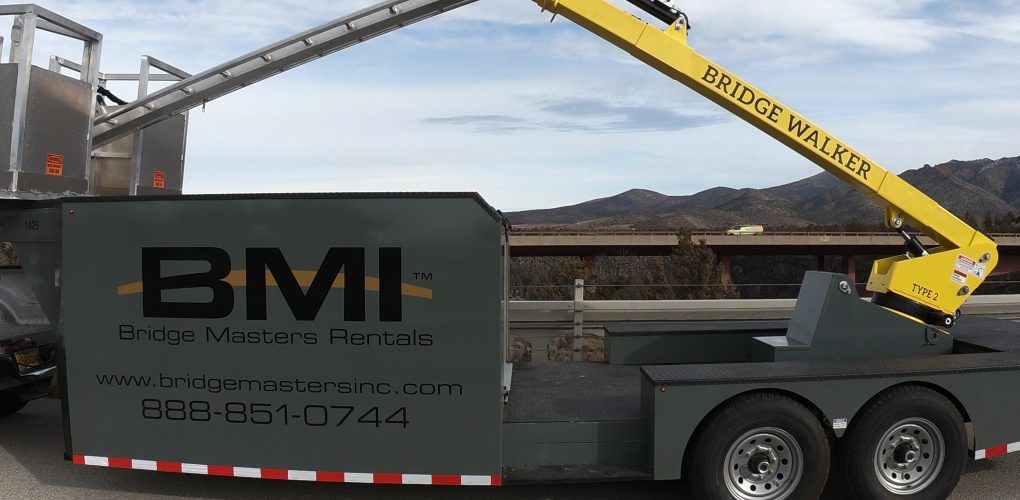
America’s aging bridges are under pressure—from decades of wear, limited funding, and rising public safety concerns. Bridge inspections aren’t just a regulatory requirement anymore; they’re a lifeline for communities and the crews working to keep them safe.
At BridgeMasters, Inc., we work side by side with inspection teams every day, delivering bridge inspection equipment that brings safety, speed, and reach to their work. From under-bridge platforms to specialty lifts, we make hard-to-access inspections possible.
Below, we break down the most common bridge inspection methods, along with their pros, cons, and the tools that can help make each method safer and more efficient.
Visual Bridge Inspection
The visual inspection is the most common and accessible type of bridge inspection. It involves visually assessing the bridge for damage, such as cracks, spalling, or corrosion, either with the naked eye or with assistance from bridge inspection tools like drones or aerial lifts.
Pros:
- Quick and cost-effective
- Requires minimal training
- Can be performed frequently
- Useful for spotting surface-level damage
Cons:
- Limited to visible surfaces
- Cannot detect internal or subsurface issues
Bottom Line: Visual inspection is the first line of defense in any bridge inspection program. When paired with reliable bridge inspection equipment—like under-bridge access platforms from BridgeMasters—it becomes even more effective, enabling teams to safely inspect hard-to-reach areas.
Acoustical Inspection
Acoustical inspections involve dragging a chain or tapping a hammer across the bridge surface and listening for sound changes that may indicate subsurface defects, such as delamination.
Pros:
- Simple and quick
- Requires minimal equipment
- Can help detect hidden voids or separations
Cons:
- Subjective interpretation of sound
- Not effective on bridges with asphalt overlays
Bottom Line: While this method has its limitations, it’s a useful supplement to visual inspections when surface damage is suspected. As always, having the right bridge inspection tools on hand improves safety and efficiency.
Infrared / Thermal Imaging Inspection
Infrared or thermal imaging goes beyond the surface, identifying temperature anomalies that could indicate voids, water ingress, or material delamination.
Pros:
- Non-destructive and efficient
- Can reveal hidden defects not visible to the eye
- Produces actionable data when conditions are right
Cons:
- Doesn’t work on asphalt overlays
- Requires favorable temperature conditions
- Interpretation requires expertise
Bottom Line: Thermal inspections are a valuable part of any bridge inspection strategy, especially when integrated with other techniques and supported by safe access solutions to capture accurate readings.
Coring and Chipping
This more invasive method involves removing samples of concrete to analyze material composition, steel reinforcement, and signs of internal corrosion.
Pros:
- Provides in-depth information about material condition
- Effective for diagnosing internal deterioration
Cons:
- Can compromise the bridge’s integrity if not repaired properly
- More labor-intensive and disruptive
Bottom Line: Used sparingly and strategically, coring helps confirm the presence and extent of structural damage. Afterward, quick and precise repairs are crucial to prevent further degradation.
Ground-Penetrating Radar (GPR) Inspection
GPR is a non-destructive method that uses electromagnetic waves to detect voids, cracks, and delamination beneath the surface of bridge decks and structures.
Pros:
- Offers objective, quantifiable data
- Highly accurate
- Detects issues not visible through visual or acoustic means
Cons:
- Requires skilled professionals to interpret data
- High energy use
Bottom Line: GPR is an essential part of modern bridge inspections, especially for aging infrastructure. Reliable bridge inspection equipment, like aerial platforms from BridgeMasters, Inc., can position radar systems exactly where they’re needed.
Half-Cell Potential Inspection
This electrochemical method detects early-stage corrosion in steel reinforcement by measuring voltage differences on the concrete surface.
Pros:
- Identifies corrosion before major damage occurs
- Fast and effective when performed correctly
- Doesn’t require direct access to steel
Cons:
- More expensive than simpler methods
- Requires training for accurate results
Bottom Line: Though more costly, half-cell inspections are worth the investment for long-term maintenance planning. They help prioritize repairs and prolong bridge life.

Final Thoughts
Every bridge inspection method—whether visual, thermal, or structural—has a place in a strong maintenance program. But no method works without the right access. That’s where Bridge Masters, Inc. comes in.
With over 20 decades of experience and a fleet of advanced bridge inspection tools, we help inspection crews reach what others can’t. We also work closely with engineers during inspections to ensure crews have the access and support they need. Our under-bridge platforms, bridge lifts, and rental solutions are built for real-world challenges—from tight deadlines to complex terrain.
Planning your next inspection? Contact us. Our team can help you choose the right bridge inspection equipment to get the job done safely and efficiently.

